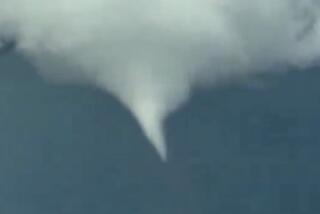Weather conditions were ideal for tornado that slammed Oklahoma
The city of Moore, Okla., was struck by a devastating tornado Monday because all the familiar ingredients were in place to spawn such a massive storm.
It was also a victim of simple bad luck.
At least twice before in recent years, in 1999 and 2003, destructive twisters have struck the Oklahoma City suburb. Experts said they knew of no scientific reason why Moore became a target yet again.
“If I gave you 1,000 darts and blindfolded you, and you threw the darts, some would cluster together,” said Robin Tanamachi, a postdoctoral researcher at the National Severe Storms Laboratory in nearby Norman, Okla. “That’s, I think, what’s happening here. It’s a random statistical fluke. Moore has been unlucky.”
Scientists sifting through the tornado’s wreckage Tuesday said it made perfect sense that a killer storm would emerge in this part of the Plains at this time of year. Warm, humid air from the Gulf of Mexico combines there with dry air from the Rockies, generating swirling winds that can spawn massive thunderstorms — and twisters, when conditions are right. Oklahoma sits squarely in a region that has earned the nickname Tornado Alley.
Meteorologists in the National Weather Service’s forecast office in Norman have upgraded Monday’s storm from an EF-4 to an EF-5 intensity rating — the highest severity a tornado can achieve on the Enhanced Fujita Scale, which rates tornado strength by assessing the damage a twister inflicts.
Conditions were ripe for a storm that day, with plenty of warm, moist air near the ground and temperatures that dropped unusually rapidly as elevations increased, said Howard Bluestein, a tornado researcher at the University of Oklahoma in Norman.
The twister was estimated to have followed a path nearly 20 miles long, remaining on the ground for about 50 minutes. Most tornadoes are over within 10 minutes.
Bluestein called Moore’s string of bad luck “remarkable.”
Early readings of radar collected in the area also painted a picture of a particularly devastating storm, researchers said.
Kevin Knupp, an atmospheric scientist at the University of Alabama in Huntsville, used radar to watch the tornado develop in real time from his office.
Observing the signal with a graduate student, Knupp estimated that the twister spewed debris across a path two miles wide. He said another dissipating storm in the area may have caused a surge in momentum in low-level air, which in turn could have fed the circulation of the powerful twister.
Tanamachi, who specializes in using radar to build computer simulations of severe storms, said that the Newcastle-Moore tornado, as the weather service refers to it, intensified unusually rapidly.
On Monday, she was stationed about five miles south of the tornado’s eventual path when radar signals indicated that a super-cell thunderstorm was beginning to develop. Scanning the storm every 60 to 90 seconds and paying attention to details like the size of water droplets, she was able to tell that it was still in an early stage and was “ingesting moist air,” which is a common fuel source for a tornado.
Tanamachi said she was surprised by the speed with which the tornado emerged.
“It went from being a benign-looking blip to a super cell in 10 to 15 minutes,” she said. “All the ingredients were there at the right time.”
Tanamachi took a video of the tornado out her window, and later posted it to YouTube.
She said that she’d like to use the data, in addition to observations collected from at least three other radars that were trained on the storm, to “re-create the storm inside a computer.”
By doing so, scientists might be able to pinpoint why the tornado was able to ramp up so quickly.
“Exploring exactly what factors controlled the intensification will be incredibly important for weather forecasting in the future,” she said.
Bluestein said he actually missed the big event. On Sunday, he and his team measured wind speeds over 200 mph in tornadoes that hit near Shawnee, Okla. Forecasts had indicated that the most severe storms Monday would strike farther south, so he and his team chased another storm, which never produced a tornado.
“We have to figure out why we were wrong,” Bluestein said.







